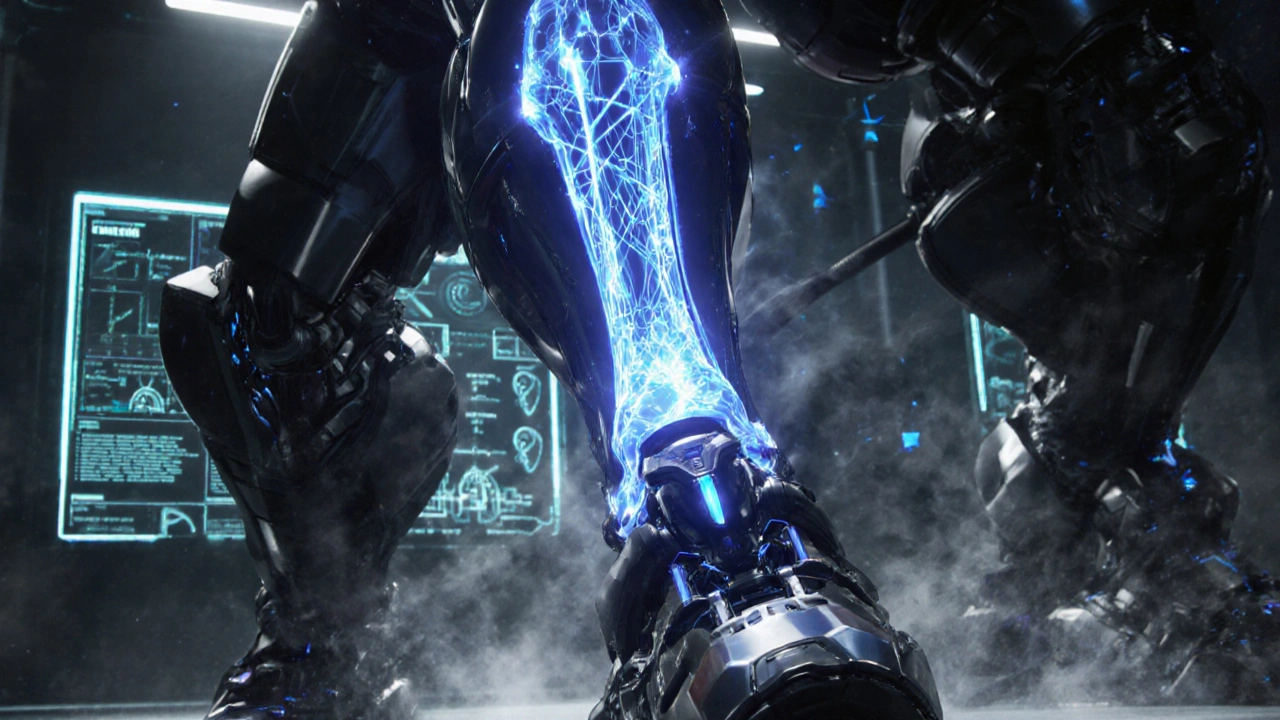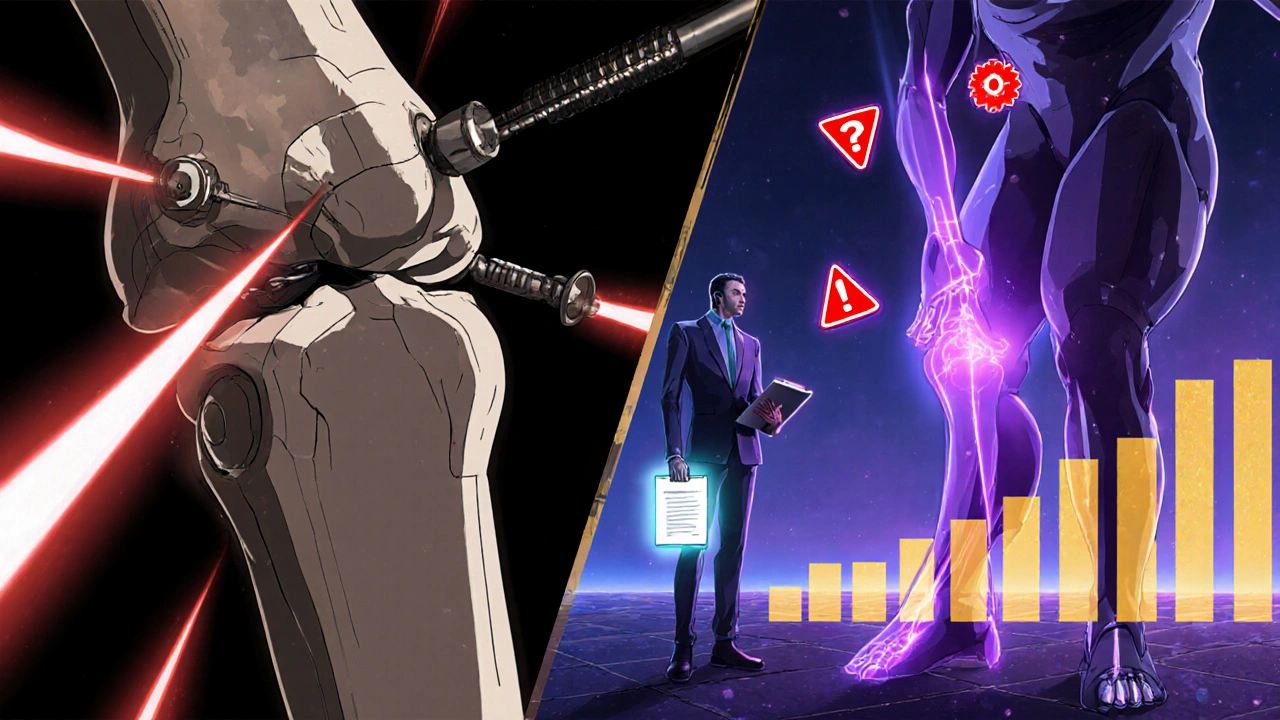
When your tendon hurts during movement-whether it’s the back of your heel after running or the front of your knee after jumping-you’re not just dealing with inflammation. You’re dealing with tendinopathy. This isn’t a simple sprain or strain. It’s a degenerative change in the tendon’s structure, often caused by repeated stress without enough recovery. Unlike acute injuries, tendinopathy doesn’t heal with rest alone. And while corticosteroid shots might offer quick relief, they often fail in the long run. The real solution? A proven, evidence-based approach: eccentric training.
What Exactly Is Tendinopathy?
Tendinopathy affects tendons-the tough cords that connect muscle to bone. It’s most common in the Achilles (heel), patellar (knee), and rotator cuff (shoulder) tendons. Athletes get it, but so do office workers who suddenly start gardening or climb stairs too often. The hallmark is pain that starts during activity, lingers afterward, and can eventually show up even at rest. Swelling might be visible, but often it’s not. The real problem? The tendon’s collagen fibers have become disorganized and weak. That’s why rest doesn’t fix it. You need to rebuild the tissue from the inside out.Why Eccentric Training Works
Eccentric training means focusing on the lowering phase of a movement-the controlled lengthening of the muscle-tendon unit. Think of slowly lowering yourself down from a step, or lowering a weight with control. This isn’t just about strength. It’s about sending the right signals to your tendon. Research since the late 1990s, starting with Alfredson’s heel-drop protocol, has shown that eccentric loading stimulates tendon cells to produce new, organized collagen. Ultrasound studies confirm that after 8-12 weeks of consistent training, the tendon becomes stiffer and more resilient. In one study, Achilles tendons showed a 15-20% increase in stiffness. That’s not just less pain-it’s a stronger, more durable tendon.How to Do Eccentric Training Right
The protocol changes depending on which tendon is affected. Here’s what works:- For Achilles tendinopathy: Stand on a step with your heels hanging off. Rise up on both feet, then shift weight to the affected side and slowly lower your heel down over 3-5 seconds. Do 3 sets of 15 reps, twice a day. Do some with your knee straight (targets gastrocnemius) and some with your knee bent (targets soleus). Rest 60-90 seconds between sets.
- For patellar tendinopathy: Use a 25-degree decline board. Stand on one leg and slowly lower into a squat, keeping your knee aligned over your toes. Lower for 3-5 seconds, then use both legs to stand back up. Do 3 sets of 15 reps daily. Many people find this painful at first-but that’s normal.
Both protocols require at least 12 weeks to show structural changes. Most people start feeling better around week 6, but the tendon keeps remodeling until week 12. Skipping ahead or stopping early is why so many people relapse.
Heavy Slow Resistance (HSR): A Strong Alternative
Not everyone tolerates classic eccentric training. Some find the initial pain too intense. That’s where heavy slow resistance (HSR) comes in. Instead of just lowering slowly, you lift and lower the weight with control-3 seconds up, 3 seconds down-using 70% of your one-rep max. You do 3 sets of 15 reps, three times a week. A 2015 study comparing HSR to eccentric training for Achilles tendinopathy found both groups improved by 60-65% on the VISA-A pain scale. But HSR had better adherence-87% stuck with it versus 72% for eccentric training. Why? Less sharp pain at the start. If you’ve tried eccentric training and quit because it hurt too much, HSR might be your better option.
Isometric Exercises: Quick Pain Relief
Eccentric training is for long-term healing. But what if you need to run a race next week or play with your kids today? Isometric exercises can help. An isometric hold is when you contract a muscle without moving the joint. For Achilles, stand on a step and push up, then hold the top position for 45 seconds. For patellar, sit with your leg straight and squeeze your quad as hard as you can for 45 seconds. Do 5 sets, 4 times a day. Studies show isometrics reduce pain by 50% within minutes. That’s not a placebo-it’s a neurological effect. The brain temporarily stops sending pain signals. It doesn’t fix the tendon, but it gives you a window to move, train, or even sleep without pain. Use it before activity. Don’t use it instead of eccentric training.Injection Options: What Actually Helps?
Injections are common-but not all are created equal.- Corticosteroid injections: These give fast relief-30-50% less pain in 4 weeks. But they weaken the tendon over time. A 2013 BMJ study found 65% of patients needed another treatment within 6 months. Only 35% of those who did eccentric training did. Avoid these unless you’re in crisis and have no other options.
- Platelet-rich plasma (PRP): This sounds promising: you inject your own concentrated blood platelets to trigger healing. But a 2020 review in the American Journal of Sports Medicine showed PRP only beat placebo by 15-20% at 6 months. Not enough to justify the cost or discomfort. It’s not recommended as a first-line treatment.
- Ultrasound-guided dry needling or sclerosing agents: These target abnormal blood vessels around the tendon that may contribute to pain. Some clinics offer them, but evidence is still emerging. Not yet standard care.
Bottom line: Injections are temporary fixes. Eccentric training is a long-term rebuild. If you’re considering an injection, make sure you’re also starting a rehab program. Otherwise, you’re just delaying the real work.
Why So Many People Fail
You’ve probably heard someone say, “I did the heel drops for 3 weeks and nothing happened.” That’s because they didn’t do them long enough-or correctly. Studies show:- 68% of patients report high pain in the first two weeks. Many quit.
- 89% of negative reviews cite “no immediate results.” But healing takes time.
- 76% of patellar tendinopathy patients struggle with form on decline squats.
- Only 38% of self-managed patients understand what “acceptable pain” means.
Acceptable pain is a 2-5 out of 10 during exercise. Harmful pain is above 7, or pain that lasts more than 24 hours. If you’re in severe pain, stop. Don’t push through. But don’t quit because it’s uncomfortable.
People who succeed work with a physical therapist for at least one session to nail the technique. A 2023 study found 92% of those who got professional guidance succeeded, versus 68% who went it alone. Apps like Tendon Rehab (version 3.2, 2023) help with form and tracking-and boost adherence from 65% to 85%.

What’s Next for Tendinopathy Treatment?
The field is moving beyond one-size-fits-all protocols. Researchers now know that not everyone responds to eccentric training-about 30% of patients are non-responders. Why? It could be tendon position on the continuum (early vs. late stage), genetics, or even psychological factors like fear of movement. New trials are testing personalized rehab. One 2022 study used load tolerance tests to tailor the intensity and volume of exercise to each person’s tendon. Results improved by 25% compared to standard protocols. Future options include peptides that activate tendon cells-still in early trials-but the real breakthrough might be in combining exercise with better load management. That means not just doing the exercises, but also adjusting your daily activity, footwear, and training volume to match your tendon’s capacity.Real People, Real Results
On running forums and physical therapy groups, the stories are consistent:- 82% of runners who completed 12 weeks of eccentric training returned to their previous activity level.
- 42% saw visible tendon thickening on ultrasound after 3 months.
- 67% of those who stuck with it had no recurrence after 2 years.
- Those who quit early or skipped sessions had 3x higher relapse rates.
The message is clear: this isn’t magic. It’s hard, it’s slow, and it’s messy. But for most people, it works.
What Should You Do?
If you have tendinopathy:- Don’t rely on injections for a cure. Use them only if you need short-term relief to start rehab.
- Start eccentric training or HSR-choose the one you can tolerate.
- Do it for at least 12 weeks. No shortcuts.
- Use isometrics for daily pain relief, not as a replacement.
- Get technique checked by a physical therapist-even once.
- Track your pain daily. Aim for 2-5/10 during exercise, not zero.
- Don’t increase your running or jumping volume until your tendon is pain-free during daily tasks.
Tendinopathy isn’t a life sentence. It’s a signal that your tendon needs better care. The tools to fix it exist. You just need to stick with them.
Is eccentric training the only treatment for tendinopathy?
No, but it’s the most proven conservative treatment. Heavy slow resistance training works just as well for many people, especially those who can’t tolerate the initial pain of eccentric exercises. Isometric exercises help with short-term pain relief. Injections like corticosteroids offer temporary relief but don’t fix the tendon and can even weaken it over time. Surgery is only considered after 6-12 months of failed conservative care.
How long does it take to see results from eccentric training?
Most people notice reduced pain around week 6, but real structural changes in the tendon take 8-12 weeks. Ultrasound imaging shows improved collagen alignment after 3 months. Stopping before 12 weeks greatly increases the chance of relapse. Consistency matters more than intensity.
Can I still run or play sports while doing eccentric training?
Yes, but you need to modify your activity. Don’t push through sharp pain. Reduce your mileage or intensity if pain goes above 5/10 during or after activity. Use isometric holds before exercise to reduce pain. Many athletes continue training at a lower volume while rehabbing. The goal is to keep loading the tendon without overwhelming it.
Why do some people say eccentric training didn’t work for them?
Most often, it’s because they didn’t do it long enough, didn’t do it correctly, or stopped when it hurt. About 30% of people don’t respond to standard protocols-this isn’t failure, it’s individual variation. Some need HSR instead, others need more load management or psychological support. If one method doesn’t work, try another. Don’t give up.
Should I get an ultrasound or MRI before starting treatment?
Not always. Tendinopathy is usually diagnosed based on symptoms and physical exam. Imaging can show tendon thickening or disorganization, but the severity doesn’t always match the pain level. Many people with severe-looking scans feel fine, and others with mild changes have intense pain. Focus on how you feel and how you respond to exercise. Imaging is helpful if symptoms don’t improve after 3 months of rehab.
Are there any risks with eccentric training?
The main risk is doing it too aggressively too soon. This can worsen pain or cause muscle soreness. That’s why starting with lower reps and slower progressions is better. If you feel sharp, localized pain that lasts more than 24 hours, you’re overdoing it. Also, poor form-like letting your knee cave inward during squats-can strain other joints. A single session with a physical therapist can prevent these issues.

Shivam Goel
November 25, 2025 AT 06:59Let’s be real-eccentric training isn’t magic, it’s math. The 8-12 week window? That’s not a suggestion, it’s a biological requirement. Collagen turnover takes time. You can’t rush the extracellular matrix. And yet, 68% of people quit before week 2 because their pain tolerance is lower than their Instagram scrolling patience. The data doesn’t lie: if you’re not doing 3x15 twice daily with 3-5 second eccentrics, you’re not training-you’re just stretching with delusions.
Arup Kuri
November 26, 2025 AT 11:19They say eccentric training works but nobody tells you the PTs are paid by the equipment companies. You think they want you to heal? No-they want you to keep coming back. Corticosteroids are banned because they’re cheap. PRP? That’s just your blood with a markup. And don’t get me started on those apps-they track your pain so they can sell your data to pharma. This whole system is rigged. Do the heel drops if you want. But know who profits.
Elise Lakey
November 27, 2025 AT 15:10I’ve been dealing with patellar tendinopathy for 14 months. I tried everything-rest, ice, foam rolling, even acupuncture. Nothing worked until I started the decline board squats. It hurt like hell the first week, but I stuck with it. Now, at week 9, I’m running again. Not fast, not far-but I’m moving. I just wanted to say thank you for writing this. It’s the first time I felt like someone actually understood what this feels like.
Timothy Sadleir
November 27, 2025 AT 21:07While the empirical evidence supporting eccentric loading protocols is statistically significant, one must consider the epistemological limitations of biomechanical reductionism. The tendon is not merely a passive tensile structure; it is an integrated sensory organ embedded within a complex neuromuscular ecosystem. To isolate it as a target for mechanical stimulus neglects the holistic nature of human adaptation. Furthermore, the reliance on ultrasound metrics as a proxy for functional recovery may be fundamentally flawed.
Roscoe Howard
November 27, 2025 AT 21:09Let me tell you something about American healthcare. You think this protocol was developed here? No. It was developed in Sweden. By Swedes. Who don’t take shortcuts. Who don’t chase quick fixes. Who don’t pay for PRP injections because they know rest and repetition work. Meanwhile, we’re out here buying $800 braces and watching YouTube rehab videos while our tendons turn to mush. We need to stop outsourcing our discipline. Do the damn heel drops. Like a real person.
Lisa Odence
November 29, 2025 AT 05:14Okay but can we talk about how the word ‘tendinopathy’ sounds like a spell from Harry Potter? 🧙♂️💥 I literally Googled it three times before I understood what it meant. Also-why is no one talking about how the decline board makes your calves scream like a banshee? I did 3 sets and cried into my protein shake. But… it worked. So I’m gonna keep doing it. And also, I bought a new pair of Asics. Because why not? 🤷♀️👟
Agastya Shukla
November 29, 2025 AT 16:13From a biomechanical standpoint, the load-tolerance paradigm is critical. Eccentric training induces tenocyte mechanotransduction via integrin-mediated signaling pathways, triggering upregulation of COL1A1 and downregulation of MMP-13. However, individual variability in tendon morphology-particularly in the Achilles tendon’s helical fiber architecture-can significantly modulate response. This explains why 30% are non-responders. Personalized load progression, guided by real-time force plate data, may be the next frontier. Also, sleep quality modulates collagen synthesis-don’t underestimate recovery.
Rachel Villegas
November 30, 2025 AT 10:02I’m not an athlete. I’m a librarian who started walking my dog uphill. Now I can’t climb stairs. I did the heel drops for 10 weeks. It was boring. It was hard. But I did it every morning before coffee. I didn’t track it. I didn’t use an app. I just showed up. And now, I can walk up the library steps without wincing. Sometimes the simplest things work the best.
Emily Craig
November 30, 2025 AT 22:27So you’re telling me I have to do 90 reps a day for 3 months… for a tendon? That’s not rehab. That’s a cult. 😅 But honestly? I tried it. I did the heel drops while watching Netflix. I cried. I swore. I almost quit. But then I ran 5K last weekend. And I didn’t hate it. So… maybe it works? 🤷♀️ Still think the PTs are just selling hope though.
Karen Willie
December 2, 2025 AT 01:47For anyone feeling overwhelmed-start small. One set. One rep. Just get the movement right. You don’t need to crush it on day one. Progress isn’t linear. Some days will feel terrible. That’s okay. Healing isn’t about being strong every day. It’s about showing up when you’re tired, scared, or sore. You’ve got this. I believe in you.
Leisha Haynes
December 3, 2025 AT 21:28PRP is just a fancy way of saying ‘we put your blood in a centrifuge and charged you $1200’… and then you still have to do the heel drops anyway. 😒 I did PRP, then did eccentric training. The PRP didn’t do anything. The heel drops did. So save your money. And your blood. And your trust.
Jefriady Dahri
December 5, 2025 AT 06:40Just wanted to say-this post saved me. I’m 32, a dad of two, and I thought I’d never run again. I did the heel drops for 14 weeks. Missed two days because my kid threw up. Didn’t matter. Kept going. Now I can play with my boys without wincing. And I even did a 10K last month. It’s not glamorous. It’s not fast. But it’s mine. Thank you for the clarity. 🙏
Andrew McAfee
December 5, 2025 AT 11:23Interesting how the West obsesses over eccentric training while in India, we’ve been doing barefoot heel drops on temple steps for centuries. No ultrasound. No apps. Just gravity and patience. Maybe we didn’t need to reinvent the wheel. Maybe we just forgot how to listen to our bodies.
Andrew Camacho
December 5, 2025 AT 15:52Let me tell you what they DON’T tell you. The tendon isn’t broken. It’s betrayed you. It’s been screaming for weeks, months, years-and you ignored it because you were too busy chasing PRs, posting gym selfies, or running marathons on sore knees. Now it’s saying ‘enough.’ And instead of listening, you want a shot. A pill. An app. A miracle. But the truth? The tendon doesn’t care about your hustle. It only cares about consistency. So stop looking for shortcuts. Start honoring your body. Or keep suffering. Your call.